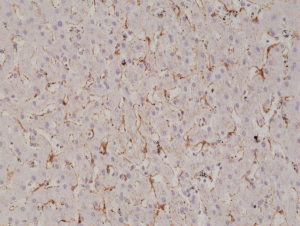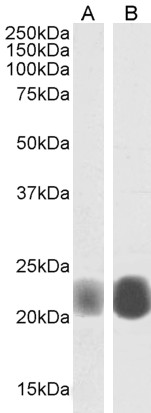
Immunohistochemical staining of formalin fixed and paraffin embedded human liver tissue section using anti-Caveolin-1 rabbit monoclonal antibody (Clone RM325) at a 1:1000 dilution.
anti-Caveolin-1 (human), Rabbit Monoclonal (RM325)
REV-31-1212-00
ApplicationsWestern Blot, ImmunoHistoChemistry
Product group Antibodies
ReactivityHuman
TargetCAV1
Overview
- SupplierRevMAb Biosciences
- Product Nameanti-Caveolin-1 (human), Rabbit Monoclonal (RM325)
- Delivery Days Customer10
- ApplicationsWestern Blot, ImmunoHistoChemistry
- CertificationResearch Use Only
- ClonalityMonoclonal
- Clone IDRM325
- Gene ID857
- Target nameCAV1
- Target descriptioncaveolin 1
- Target synonymsBSCL3, CGL3, LCCNS, MSTP085, PPH3, VIP21, caveolin-1, caveolin 1, caveolae protein, 22kDa, cell growth-inhibiting protein 32
- HostRabbit
- IsotypeIgG
- Protein IDQ03135
- Protein NameCaveolin-1
- Scientific DescriptionCaveolin-1 or CAV1 is a scaffolding protein within caveolar membranes. It interacts directly with G-protein alpha subunits and can functionally regulate their activity. Caveolin-1 is also involved in the co-stimulatory signal essential for T cell receptor (TCR) mediated T cell activation. It can bind with DPP4 and induces T cell proliferation and NF-kappa-B activation in a T cell receptor/CD3-dependent manner. Mutations affecting the CAV1 gene can result in congenital generalized lipodystrophy 3, pulmonary hypertension primary 3, or partial lipodystrophy/congenital cataracts and neurodegeneration syndrome. - Recombinant Antibody. This antibody reacts to human Caveolin-1. Applications: WB, IHC. Source: Rabbit. Liquid. 50% Glycerol/PBS with 1% BSA and 0.09% sodium azide. Caveolin-1 or CAV1 is a scaffolding protein within caveolar membranes. It interacts directly with G-protein alpha subunits and can functionally regulate their activity. Caveolin-1 is also involved in the co-stimulatory signal essential for T cell receptor (TCR) mediated T cell activation. It can bind with DPP4 and induces T cell proliferation and NF-kappa-B activation in a T cell receptor/CD3-dependent manner. Mutations affecting the CAV1 gene can result in congenital generalized lipodystrophy 3, pulmonary hypertension primary 3, or partial lipodystrophy/congenital cataracts and neurodegeneration syndrome.
- ReactivityHuman
- Storage Instruction-20°C
- UNSPSC12352203





